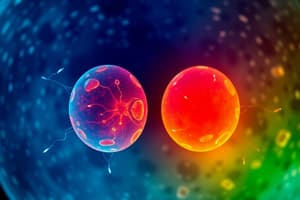Podcast
Questions and Answers
What is the chromosome number of the cells produced at the end of mitosis, starting from a diploid cell?
What is the chromosome number of the cells produced at the end of mitosis, starting from a diploid cell?
- Variable, depending on the organism
- Haploid (n)
- Diploid (2n) (correct)
- Tetraploid (4n)
Which process directly contributes to increasing the number of somatic cells in a developing organism?
Which process directly contributes to increasing the number of somatic cells in a developing organism?
- Meiosis
- Fertilization
- Gamete formation
- Mitosis (correct)
How does the genetic information in the daughter cells produced by mitosis compare to that of the original cell?
How does the genetic information in the daughter cells produced by mitosis compare to that of the original cell?
- Daughter cells have the same the genetic information. (correct)
- Daughter cells have a unique combination of genetic information.
- Daughter cells have half the genetic information.
- Daughter cells have double the genetic information.
What is the ploidy of the cells produced after Meiosis I?
What is the ploidy of the cells produced after Meiosis I?
Which of the following statements accurately describes the role of meiosis in sexual reproduction?
Which of the following statements accurately describes the role of meiosis in sexual reproduction?
What is a key difference in the events that happen in Meiosis I compared to Meiosis II
What is a key difference in the events that happen in Meiosis I compared to Meiosis II
In what type of cells does mitosis occur?
In what type of cells does mitosis occur?
A cell with 46 chromosomes undergoes meiosis. How many chromosomes will be present in each of the daughter cells after meiosis II is complete?
A cell with 46 chromosomes undergoes meiosis. How many chromosomes will be present in each of the daughter cells after meiosis II is complete?
Given that mitosis is a cyclical process, what is the significance of interphase between successive mitotic divisions?
Given that mitosis is a cyclical process, what is the significance of interphase between successive mitotic divisions?
A researcher is studying cell division in germ cells. Which of the following processes could they observe?
A researcher is studying cell division in germ cells. Which of the following processes could they observe?
Flashcards
Mitosis
Mitosis
Cell division resulting in two identical diploid cells.
Meiosis
Meiosis
Cell division resulting in four haploid gametes with different genetic information.
Diploid
Diploid
Cells with a double set of chromosomes (2n).
Haploid
Haploid
Signup and view all the flashcards
Somatic Cells
Somatic Cells
Signup and view all the flashcards
Germ Cells
Germ Cells
Signup and view all the flashcards
Gametes
Gametes
Signup and view all the flashcards
Fertilization
Fertilization
Signup and view all the flashcards
Meiosis One
Meiosis One
Signup and view all the flashcards
Meiosis Two
Meiosis Two
Signup and view all the flashcards
Study Notes
Mitosis
- Begins with a cell that has a diploid number of chromosomes (2n).
- In humans, this is 46 chromosomes comprised of 23 from each parent forming 23 homologous pairs.
- After mitosis and cytokinesis, two cells with the same genetic information as the original are produced.
- Each new cell has a diploid number of chromosomes (2n).
- The new cells can undergo interphase again to grow, replicate DNA and centrosomes.
- Mitosis is facilitates growth, transforming single-celled organisms into complex beings.
- A cycle which each cell can repeat.
Meiosis
- Involves two phases, beginning with a cell that has a diploid number of chromosomes,
- DNA is replicated during interphase.
- Meiosis One halves the chromosome number, resulting in two cells with a haploid number of chromosomes (n).
- In humans, chromosome numbers reduce from 46 to 23 in each nucleus.
- Each of these cells then undergoes Meiosis Two, yielding four cells that each have the haploid number of chromosomes
- The four cells don't all necessarily have the same genetic information anymore.
- During Meiosis One, homologous pairs split up randomly, resulting in cells with chromosomes from both parents.
- Meiosis Two is similar to mitosis, dealing with cells that start with the haploid number.
- Meiosis is not a cycle; the resulting cells are gametes (sex cells).
- In males (testes), these are sperm cells; in females (ovaries), they are egg cells.
- In trees, these could be pollen or an ovule and these are used for fertilization.
- During sexual reproduction, gametes fuse to form a fertilized egg that undergoes mitosis to create a new organism.
Cell Types
- Mitosis occurs in somatic cells, which make up the bulk of the body.
- Meiosis occurs in germ cells (testes in males, ovaries in females).
Germ Cells
- Germ cells can undergo mitosis to produce other germ cells with a diploid number of chromosomes.
- Alternatively, germ cells can undergo meiosis to produce gametes (sperm or egg cells).
Studying That Suits You
Use AI to generate personalized quizzes and flashcards to suit your learning preferences.



